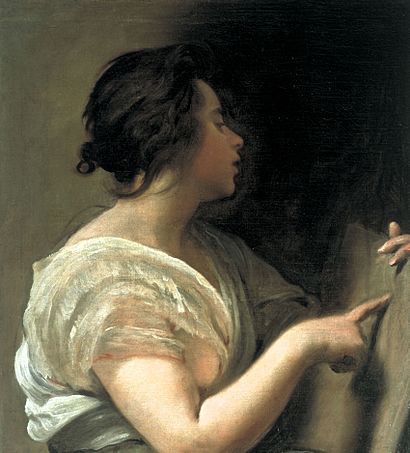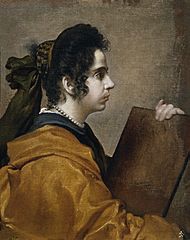Female Figure (Velázquez) facts for kids
Quick facts for kids Sibyl with Tabula Rasa |
|
|---|---|
| Spanish: Sibila con tábula rasa | |
 |
|
| Artist | Diego Velázquez |
| Year | 1648 |
| Medium | Oil on canvas |
| Dimensions | 64 cm × 58 cm (25 in × 23 in) |
| Location | Meadows Museum, Dallas |
Female Figure (also called Sibyl with Tabula Rasa, or in Spanish: Sibila con tábula rasa) is a small painting from 1648. It was painted by Diego Velázquez, a very important artist from Spain's Golden Age. This oil painting might not have been completely finished.
The woman in the painting is a bit of a mystery. Many people think she is a sibyl. Sibyls were women in ancient times who were believed to have special powers to predict the future. This idea comes from how similar this painting is to another one Velázquez made around 1631–32, called Sibyl (Portrait of Juana Pacheco?). Both paintings show women from the side, holding a tablet.
Experts believe this painting was made around 1648. This is because of how Velázquez painted it. His brushstrokes look free and flowing, like in his famous painting Rokeby Venus. This style was likely influenced by his trips to Italy, where he saw paintings by the artist Titian. Female Figure is known for its calm beauty and soft colors. The woman's slightly open lips and side view make the painting feel very poetic.
What Does the Painting Show?
In old Christian stories, sibyls were seen as prophetesses. They were thought to warn the ancient Romans about the coming of Christ. Sibyls are often shown with tablets or open books, just like the woman in this painting.
However, in many old paintings from the Renaissance and Baroque periods, sibyls wore fancy robes and head coverings. But the woman in Velázquez's painting looks different. Her hair is a bit messy, with strands falling on her neck and back. She wears simple clothes. Some people think Velázquez painted her in a very natural way, as if he caught her in the exact moment she was about to share a prophecy.
Her skin looks pale and glowing. Her lips are slightly open, as if she is about to speak. Her finger rests on a tablet that seems completely blank. This blank tablet is called a tabula rasa. It means "blank slate" in Latin. Art experts like Simona Di Nepi have noted that Velázquez often used ordinary-looking people as models for his paintings, even for important subjects. He painted them in a very realistic way, not making them look perfectly ideal.
Who is the Woman?
Many art historians have wondered if the woman in the painting is truly a sibyl. Some think she might represent painting itself. They notice she looks a bit like a figure in Velázquez's painting Fable of Arachne.
It has been suggested that Velázquez used the same person as a model for both paintings. However, other experts doubt this because Arachne's face is hidden in that painting. Also, if she represented painting, you might expect to see an easel or a paintbrush, but there are none.
Other ideas about who the woman might be include Clio, who was the muse of history in ancient Greek myths. Another suggestion is Flaminia Triunfi, a painter whom Velázquez met when he was in Italy. The true identity of the woman remains a mystery, which makes the painting even more interesting!
Gallery
-
Juana Pacheco, Wife of the Artist, as a Sibyl (?), around 1631. This painting shows a similar pose but is more formal. It was changed a lot in the 1800s, with things like jewelry added. These additions were removed in the 1920s, and then it was believed to be by Velázquez. Like the Sibyl with Tabula Rasa, it is thought to be unfinished.
See also
 In Spanish: Sibila con tábula rasa para niños
In Spanish: Sibila con tábula rasa para niños
- List of works by Diego Velázquez


